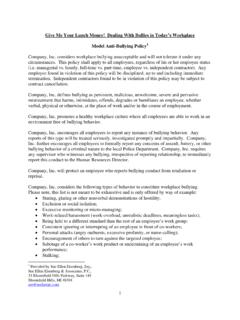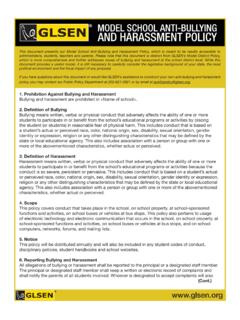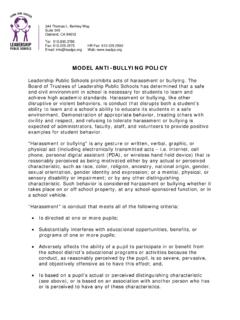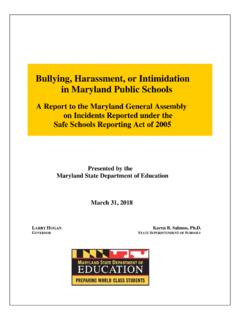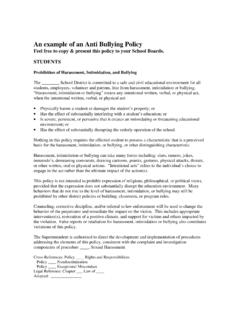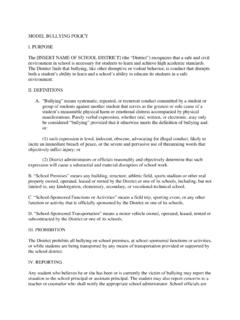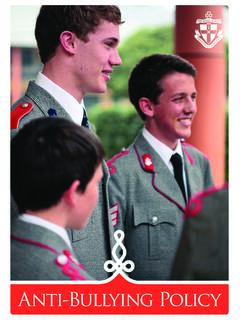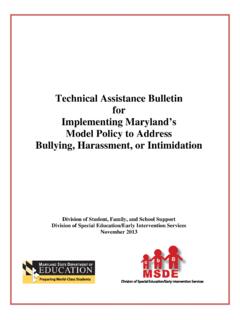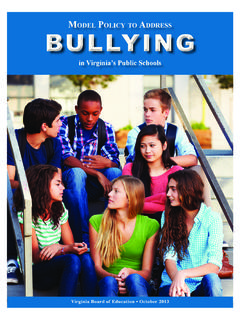Transcription of Model Anti-Bullying Policy for Schools
1 Anti-Bullying Policy February 2017 Version 1 Model Anti-Bullying Policy for Schools This Policy is based on DfE guidance Preventing and Tackling bullying . Advice for headteachers, staff and governing bodies , October 2014 and it is recommended that Schools read this guidance: 1) Objectives of this Policy This Policy outlines what Melbourne Infant school will do to prevent and tackle bullying . The Policy has been drawn up through the involvement of the whole school community and we are committed to developing an Anti-Bullying culture whereby no bullying , including between adults or adults and children and young people will be tolerated. 2) Our school community: Discusses, monitors and reviews our Anti-Bullying Policy and practice on a regular basis. Supports all staff to promote positive relationships to prevent bullying and will intervene by identifying and tackling bullying behaviour appropriately and promptly.
2 Ensures that pupils are aware that all bullying concerns will be dealt with sensitively and effectively; that pupils feel safe to learn; and that pupils abide by the Anti-Bullying Policy . Reports back to parents/carers regarding their concerns on bullying and deals promptly with complaints. Parents/ carers in turn work with the school to uphold the Anti-Bullying Policy . Seeks to learn from good Anti-Bullying practice elsewhere and utilises support from the Local Authority and other relevant organisations when appropriate 3) Definition of bullying bullying is Behaviour by an individual or a group, usually repeated over time that intentionally hurts another individual either physically or emotionally and involves an imbalance of power . (DfE Preventing and Tackling bullying , October 2014) bullying can include: name calling, taunting, mocking, making offensive comments; kicking; hitting; taking belongings; producing offensive graffiti; gossiping; excluding people from groups and spreading hurtful and untruthful rumours.
3 This includes the same inappropriate and harmful behaviours expressed via digital devices (cyberbullying refer to Online Safety Policy ) such as the sending of inappropriate messages by phone, text, Instant Messenger, through websites and social media sites and apps, and sending offensive or degrading images by mobile phone or via the internet. The school s definition of bullying is: When someone is doing or saying something hurtful to another person several times on purpose ( ) Anti-Bullying Policy February 2017 Version 1 Inevitably there will be times when children will fall out and are upset but the significant difference is that bullying is intentional, not an accident, and is usually a repeated act of bullying behaviours against other children whilst being aware that it is causing upset to the victim. 4) Forms of bullying covered by this Policy bullying can happen to anyone.
4 This Policy covers all types of bullying and peer to peer abuse including: bullying related to race, religion or culture. bullying related to SEND (Special Educational Needs or Disability). bullying related to appearance or physical/mental health conditions. bullying related to sexual orientation (homophobic and biphobic bullying ). bullying of young carers, children in care or otherwise related to home circumstances. Sexist, sexual and transphobic bullying . bullying via technology cyberbullying (refer to Online Safety Policy ) 5) Preventing, identifying and responding to bullying The school community will: Create and support an inclusive environment which promotes a culture of mutual respect, consideration and care for others which will be upheld by all. Work with staff and outside agencies to identify all forms of prejudice-driven bullying . Actively provide systematic opportunities to develop pupils social and emotional skills, including their resilience.
5 Provide a range of approaches for pupils, staff and parents/carers to access support and report concerns. Challenge practice which does not uphold the values of tolerance, non-discrimination and respect towards others. Consider all opportunities for addressing bullying in all forms throughout the curriculum and supported with a range of approaches such as through displays, assemblies, peer support and the school /student council. Regularly update and evaluate our approaches to take into account the developments of technology and provide up-to-date advice and education to all members of the community regarding positive online behaviour. Train all staff including teaching staff, support staff (including administration staff, lunchtime support staff and site support staff) and pastoral staff to identify all forms of bullying , follow the school Policy and procedures (including recording and reporting incidents).
6 Proactively gather and record concerns and intelligence about bullying incidents and issues so as to effectively develop strategies to prevent bullying from occurring. Actively create safe spaces for vulnerable children and young people. Anti-Bullying Policy February 2017 Version 1 Use a variety of techniques to resolve the issues between those who bully and those who have been bullied. Work with other agencies and the wider school community to prevent and tackle concerns. Celebrate success and achievements to promote and build a positive school ethos. Be encouraged to use social media responsibly. All bullying will be dealt with very seriously and the procedure will be as follows; Initial Action Any incident of bullying will be reported to the Headteacher, who will investigate the matter, finding further information about what has happened, the reasons for it and the feelings it has generated.
7 This discussion will take place separately with both the victim and the bully , as well as with any member of staff or adult who may have a relevant contribution to make. Record of Incident The incident will be noted in the in the school behaviour record book in Headteacher s Office Discussion with and support for victim The victim will be reassured that things will change, and that they do not need to put up with upsetting behaviour from others. If appropriate they will also be given strategies to help them if a similar incident occurs tell the person to stop, move away from the situation, seek help as soon as possible. Discussion with, and strategies to improve behaviour of the bully. The bully will have explained; the effects of bullying , the responsibility that every individual has for their own behaviour, and their responsibility to put things right if they have acted wrongly.
8 The pupil will also be encouraged to understand why they have behaved badly. They will also be given strategies to help them if a similar incident occurs If, as is likely, it is the case that the incident has happened, because the pupil has difficulty in relating to peers, then they would be given strategies that would promote positive relationships, sharing, being willing to take turns, not being rough, letting others have their say and make some decisions, etc. The pupil will be asked to say how he/she will behave in the future. Follow up Most cases in the school to date, are of a very minor nature and relate to the pupil s stage of development in their personal and social knowledge and skills, rather than active bullying . In these cases, after noting their name in the book and having the discussions referred to above they would be; Anti-Bullying Policy February 2017 Version 1 reminded about the school behaviour rules warned to improve their behaviour, told that their behaviour will be monitored asked to apologise to the victim they may also be given time to think about the consequences of their behaviour.
9 In the event of a more serious or persistent case; the investigation and discussions referred to above would take place parents would be immediately informed a plan of action would be drawn up which would be closely monitored, with meetings agreed with parents to discuss progress. 6) Involvement of pupils We will: Regularly canvas children and young people s views on the extent and nature of bullying . Ensure that all pupils know how to express worries and anxieties about bullying . Ensure that all pupils are aware of the range of sanctions which may be applied against those engaging in bullying . Involve pupils in Anti-Bullying campaigns (Friendship Week) in Schools and embedded messages in the wider school curriculum. Publicise the details of help lines and websites. Offer support to pupils who have been bullied and to those who are bullying in order to address the problems they have.
10 Raising awareness in assemblies. The children are involved in writing their own action plan to ensure they know what to do at school and even outside of school . Each class will have emoji faces (happy, sad, angry, worried, Key Stage 1 also confused) where they can attach their name card and then the teacher will intervene. 7) Liaison with parents and carers We will: Make sure that key information (including policies and named points of contact) about bullying is available to parents/carers in a variety of formats. Ensure that all parents/carers know who to contact if they are worried about bullying . Anti-Bullying Policy February 2017 Version 1 Ensure all parents/carers know about our complaints procedure and how to use it effectively. Ensure all parents/carers know where to access independent advice about bullying . Work with all parents/carers and the local community to address issues beyond the school gates that give rise to bullying .
